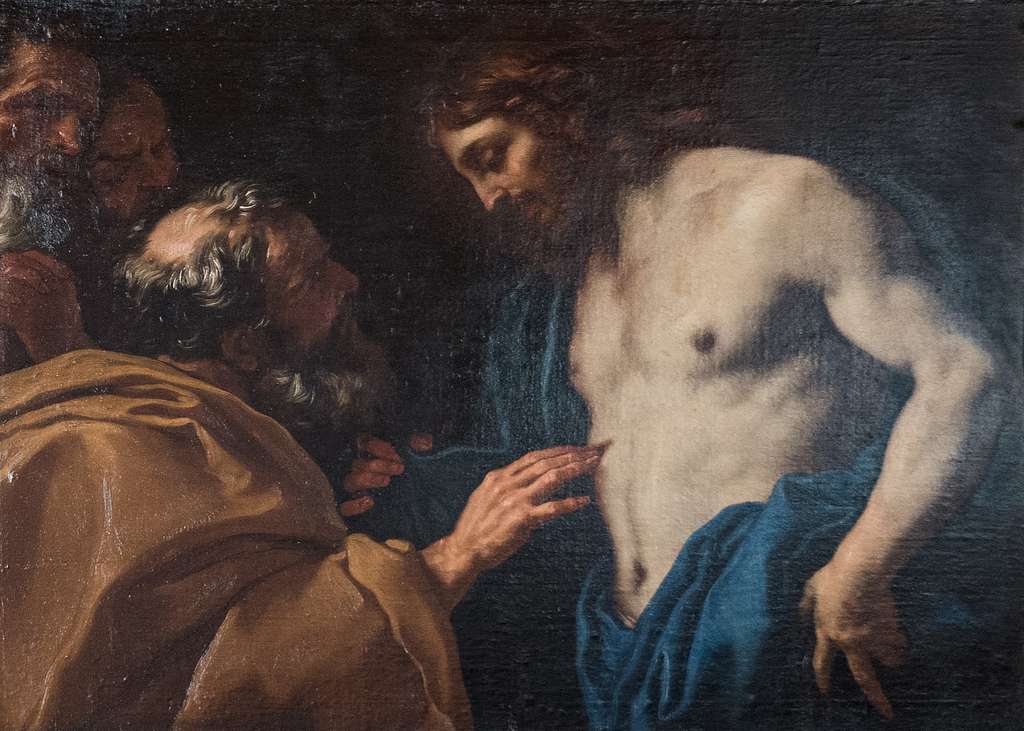“Have you come to believe because you have seen me? Blessed are those who have not seen and have believed.” (Jn 20:29)
The Apostle Thomas is often referred to as “Doubting Thomas,” but is this really fair? When Mary Magdalene finds the empty tomb, she runs to tell the Apostles. The response? Peter and John run to the tomb –– they have to see it for themselves. Once they see the empty tomb and the face cloth rolled separately (signifying that He would be back), then they believe.
When the 10 Apostles are together, Jesus appears to them, shows them His wounds, and breathes on them, saying, “Receive the Holy Spirit.” It is this act that leads the Apostles to understand the Resurrection, but Thomas isn’t with them. He doesn’t receive the signs and the Holy Spirit as the other Apostles do at this time. Is it any wonder that he remains in the state of incomprehension that the other Apostles had also been in prior to seeing the Risen Christ? (Mk 16: 11, 13)
We fail to appreciate what Thomas grappled with. He has seen Jesus raise Lazarus from the dead, but the idea of Jesus raising Himself from the dead is beyond Thomas’s understanding. We believe because we have the benefit of the Holy Spirit, the gift of Baptism, and 2000 years of Church teaching, with each generation of saints and doctors of the Church diving deeper into understanding and building on what came before — and we have Thomas, who put his fingers into Christ’s side and verifies that He is not a ghost, but fully alive in His Glorified Body.
We often fail to peel back the layers to contemplate the deeper meaning of Jesus’s response to Thomas. He doesn’t appear in anger or condemnation. He loves Thomas and is not willing to leave him in the same state the other Apostles had been in prior to His visit. He wants Thomas to have the gift of the Holy Spirit too. He has great plans for Thomas. He willingly offers the proof Thomas needs. When Thomas is greeted with such unconditional love, he knows he’s in the presence of Jesus. It is this great love that transforms Thomas just as it transformed the other Apostles.
Because Jesus is willing to meet Thomas where he is, as he is, Thomas ends up spreading the Gospel all the way to India. Thomas’s questions don’t phase Jesus; Our Lord wants him to understand and Thomas for his part comes with an open heart, willing to be taught. Thomas is truly a sign of hope for all of us. We too often struggle to understand the ways of God, and in our struggles God does not abandon us either. He meets us where we are, as we are. If we approach our questions with an open, sincere heart, willing to accept God’s timing with patience and humility, we can enter into contemplation of the divine. It is here that we, like Thomas, move beyond simply touching His side; we are drawn into a deeper relationship with Him that strengthens our faith as we place ourselves in His presence and allow ourselves to be transformed by His tender, merciful love.






I have always felt that Thomas is given a bad rap.
I once heard a really good talk given by Pastor Dick over at Jubilee. His main point was that we should look more closely at what Thomas’ response actually says. According to the Gospel of John (John 20:24-25), Thomas was not with the other disciples when Jesus first appeared to them after his resurrection. When they told him about their encounter, Thomas refused to believe them, saying:
“Unless I see the nail marks in his hands and put my finger where the nails were, AND PUT MY HAND INTO HIS SIDE, I will not believe.”
Now anyone living at the time would know that nails would be used to hang a person from a cross. Common knowledge. No surprise there.
But that second portion about putting his hand into Jesus’ side. That is somewhat unusual. It refers to the puncture wound that Christ Jesus received when the guard was checking if he was dead, or if his legs would need to be broken. That was something more unique to Jesus’ case.
The statement was made with intention and made without question. So what would make Thomas say such a thing?
Pastor’s conclusion (which makes perfect sense to me): Thomas was THERE. He witnessed the whole thing first hand. And he was probably the only one of the twelve who did.
Now I don’t know about you, but if I know something to be true because I am a first-hand witness of the thing, and someone comes along and tells me something which goes against what I myself know to be true, would I simply accept their account of things and dismiss my own understanding of the truth? Highly doubtful. So Thomas’ response is completely in line with the way most people would respond. He is not doubting their version of things so much as stating outright “I know what I saw, and what I saw does not line up with what you’re telling me. You want me to believe your version of things? Here’s what would need to happen…”.
“Doubting” Thomas? A better label would be *skeptical* Thomas, and his skepticism is not unjustified given the circumstances. Again, were I in Thomas’ shoes, I would be skeptical too. But later when Jesus appears to Thomas and shows him his wounds, Thomas’ response is immediately one of complete faith and total acceptance: “My Lord and my God!” (John 20:28)
The description provided of Thomas’ “doubt” should be looked on as the common response of any person placed in that situation. That’s the lesson I take away from this passage, anyway.
God bless.
Thank you for bringing up these details. Scripture is so rich we never stop discovering layers of meaning. God Bless you.